QUALITY CYCLING CLOTHING SINCE 1996 - THE UK'S FIRST RETRO MANUFACTURER
QUALITY CYCLING CLOTHING SINCE 1996 - THE UK'S FIRST RETRO MANUFACTURER
RETRO APPAREL
COLLECTIONS
Cycling Clothing
ACCESSORIES
Peugeot cycling team
March 20, 2019 5 min read

Eddy Merckx leads the pack in his Peugeot BP team jersey during the 1966 edition of the Tour of Lombardy. Photo credits: Mark Leech / Offside
The Peugeot retro jersey has been a staple in the Prendas retro peloton since the very beginning - it was the very first retro jersey that we had Santini make specifically for us.
Find out about the team that is as commandeered as "the most successful cycling team ever" join Pedr Charlesworth who explores the story behind the iconic French team containing Tom Simpson, Roger Pingeon, Bernard Thevenet, Eddy Merckx and Robert Millar.
The Bastion of French Cycling
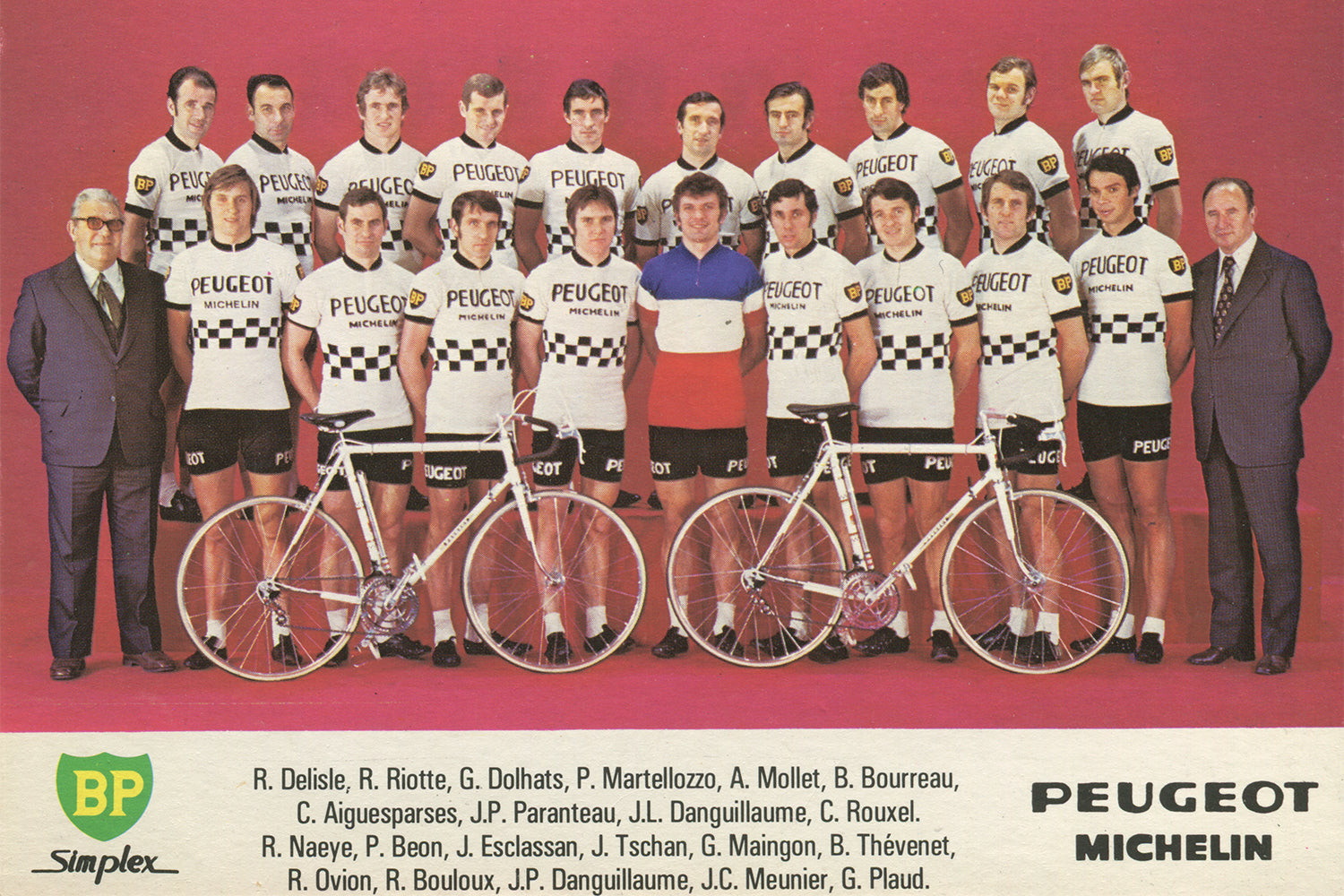
The Peugeot BP Micheling cycling team postcard from the 1974 season with French Champion Bernard Thevenet and teammates Patrick Beon, Bernard Bourreau, Jacques Esclassan et al.
Cycling, it was a different game back when Peugeot’s star riders were first battling up the steep slopes of the Pyrenees.
The first world war was yet to take place, the yellow jersey even dreamt up, and riders required resourcefulness outside the realm of cycling just to finish races. Eugène Christophe was certainly a resourceful man, meticulous in his planning, he would always be found with a 20 franc coin, chain link and spoke key in a chamois bag hung around his neck in preparation for the worst. After missing out on the overall Tour de France victory the previous year, he was leaving nothing to chance in 1913; attacking from the front on the low slopes of the Col du Tourmalet with his trusty bag swinging freely as he rode.
After launching a ceaseless barrage of attacks, Christophe’s final injection of pace proved just too much for his arch-rival Odile Defraye, causing him to retire from the competition with exhaustion. Now, over an hour clear from the rest of the field in the general classification, he could comfortably enjoy the dramatic French mountainscape unfolding before him. The procession was to last mere minutes, however, when a reckless race vehicle clipped his bike, sending him sprawling into the road and clean snapping his forks (so Peugeot claim). Weeping with anger, he shouldered the broken bike, watching the rest of the riders fly by whilst he descended the next 10km on foot to the nearest village. After locating a forge in town, he skilfully welded the mangled forks back together before completing the stage on his wounded steed.
Eventually crossing the line 3 hours after the lead pack, he was then penalised a further 10 minutes by stewards for letting a seven-year-old boy pump the bellows whilst he welded the bike. Initially judged to be too harsh, the penalty was then reduced to more ‘reasonable’ 3 minutes…
Despite Christophe never going on to win a Tour, it was these acts of cycling heroism from Peugeot riders that led the team to be ranked the most successful of all time over the forthcoming years (cycleranking.com). Starting at the turn of the century (1901), Peugeot squads performed at the very highest level for over 8 decades. In that time their stellar roster included the French talisman, Tour de France (1967) and Vuelta a España (1969) winner Roger Pingeon; 1966 Gent-Wevelgem, La Fleche Wallonne, two-time San-Remo (1966, 1967) and a Giro d’Italia stage winner, a young Eddy Merckx; Vuelta a España (1971) champion Ferdinand Bracke, and neo-pros Stephen Roche and Scot Robert Millar.
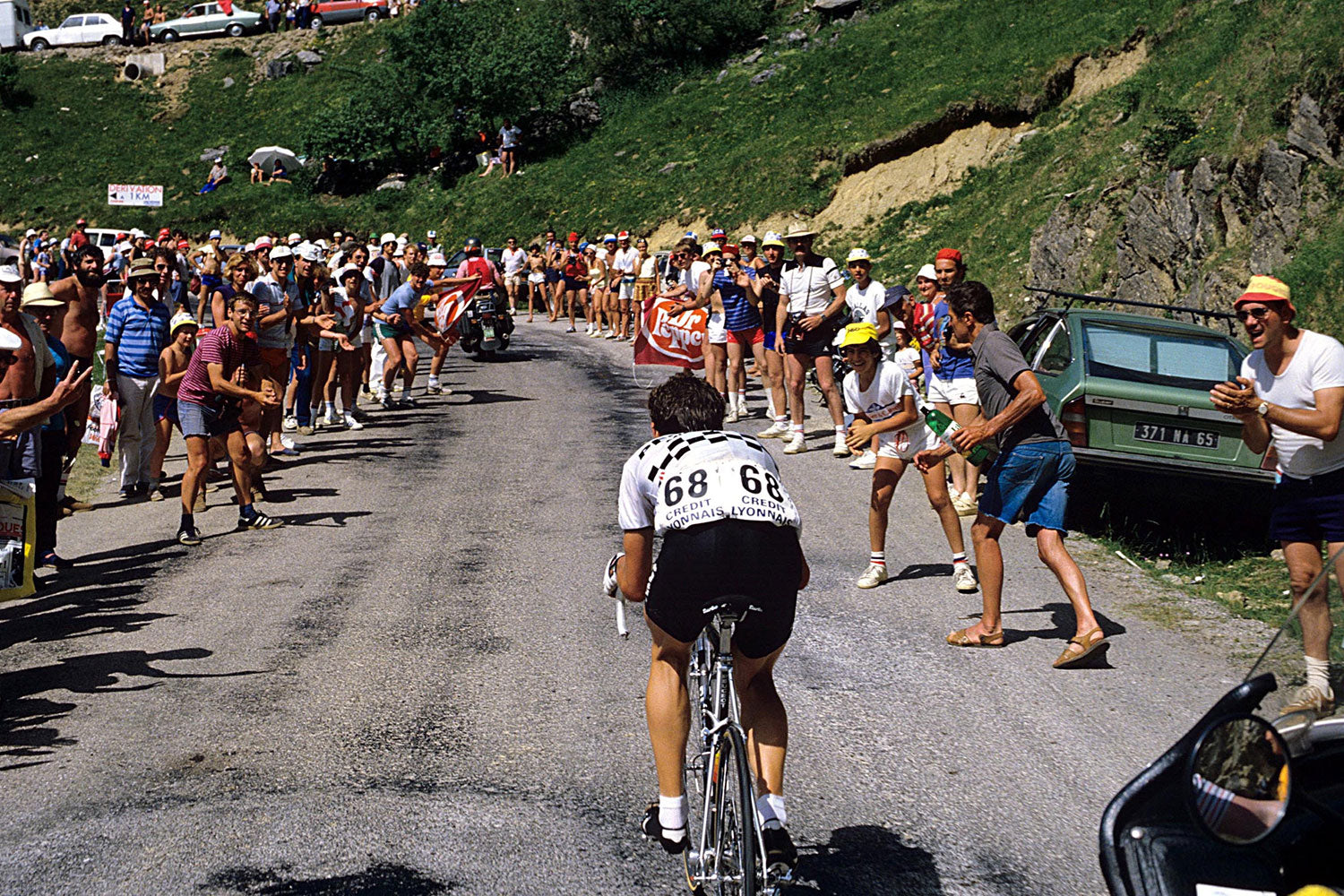
Robert Millar during stage 11 at the 1984 Tour de France - Pau to Gruzet Neige. Photo Credit: Offside / L'Equipe.
Many of these (notably Eddy Merckx, Stephen Roche and Robert Millar) went on to achieve greatness sporting other colours, yet were always grateful for their youthful years spent donning the iconic checkered jersey. It is, however, worth pointing out that the Peugeot team jersey was not always the iconic monochrome checkerboard design that we all think of.
As you can see from this collectible chewing gum postcard, Frans Schoubben is wearing the 1962 team jersey. This was the last year the Peugeot team riders wore this blue and yellow design before swapping to the more familiar black & white checkerboard design in 1963 that would pretty much remain unchanged until the 1987 with the arrival of the Vétements Z-Peugeot team.
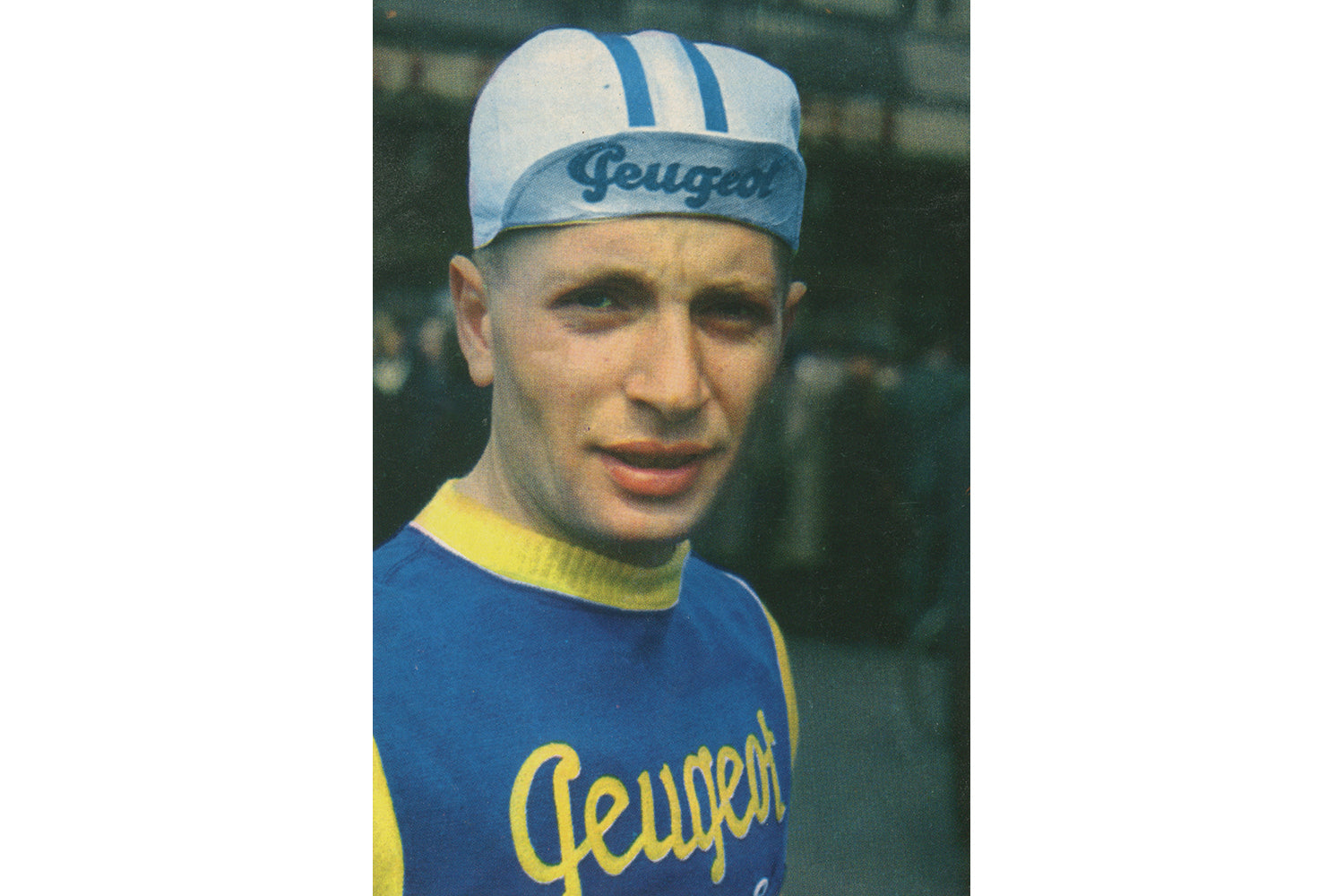
Frans Schoubben wearing the 1962 version of the Peugeot BP cycling team jersey.
Merckx, in particular, enjoyed the refuge of the friendly team and its welcoming leader after a fall out with his previous outfit, Solo-Superia, and its chieftain Rik Van Looy.
Despite being a team of French origins, Peugeot was headed by popular Briton Tom Simpson. Before taking the helm at Peugeot, he had previously vanquished Van Looy in his own backyard, when the GS Solo Superia legend crashed out of the ’61 Tour of Flanders, leaving the debutant Simpson to battle his way to victory sporting a natty pair of Ray-Bans.
 Tom Simpson climbing during Stage 10 of the 1965 Tour de France from Bagneres de Bignorre to Aix les Thermes. Photo Credits: Offside / L'Equipe.
Tom Simpson climbing during Stage 10 of the 1965 Tour de France from Bagneres de Bignorre to Aix les Thermes. Photo Credits: Offside / L'Equipe.
Simpson continued his excellent form at Peugeot, where he nurtured a rising Merckx who would eventually be the only foreign rider to attend his funeral. Before that dark day, Simpson would become the first Briton to wear the yellow jersey, win Milan-San Remo (1964) and the World Championships (1965), on top of a victory at Bordeaux-Paris (1963). Then there was Lombardy. After being roasted by the press for straight-talking about the state of race-fixing in the pro peloton, Simpson let his legs speak for themselves over the Italian climbs. It was 1965, and the home hero Gianni Motta was in his prime riding for the Molteni team. Having broken clear from the main bunch, the pair battled their way up the concluding climb in San Fermo della Battaglia, where thousands of jubilant fans cheered on their Molteni man. Despite their support, he was unable to match Simpson's pace, as the Briton surged on through the frenzied crowds, crossing the line beaming in the first place. Motta was inconsolable, and Simpson, a temporary Italian villain.
Any villainous phase could not last, however – Simpson was a crowd-pleaser.
Often seen riding up the advertising boards on the banks of velodromes to the joy of onlooking fans; he was also a popular character in the pro peloton. Amongst the riders he commanded respect for his style and ability to endure fearsome levels of suffering on the bike. It was this ability however, that meant those closest to him thought little of the Britons complexion as he pushed hard up Mt. Ventoux, on stage 13 of the ’67 Tour. Just 1km from the summit, he dropped back from the lead group, swerving across the road before collapsing off his bike. Ignoring his managers protests to stop, he re-adjusted his toe clips and rode on, managing a further 500m before falling once more – this time it would prove fatal.
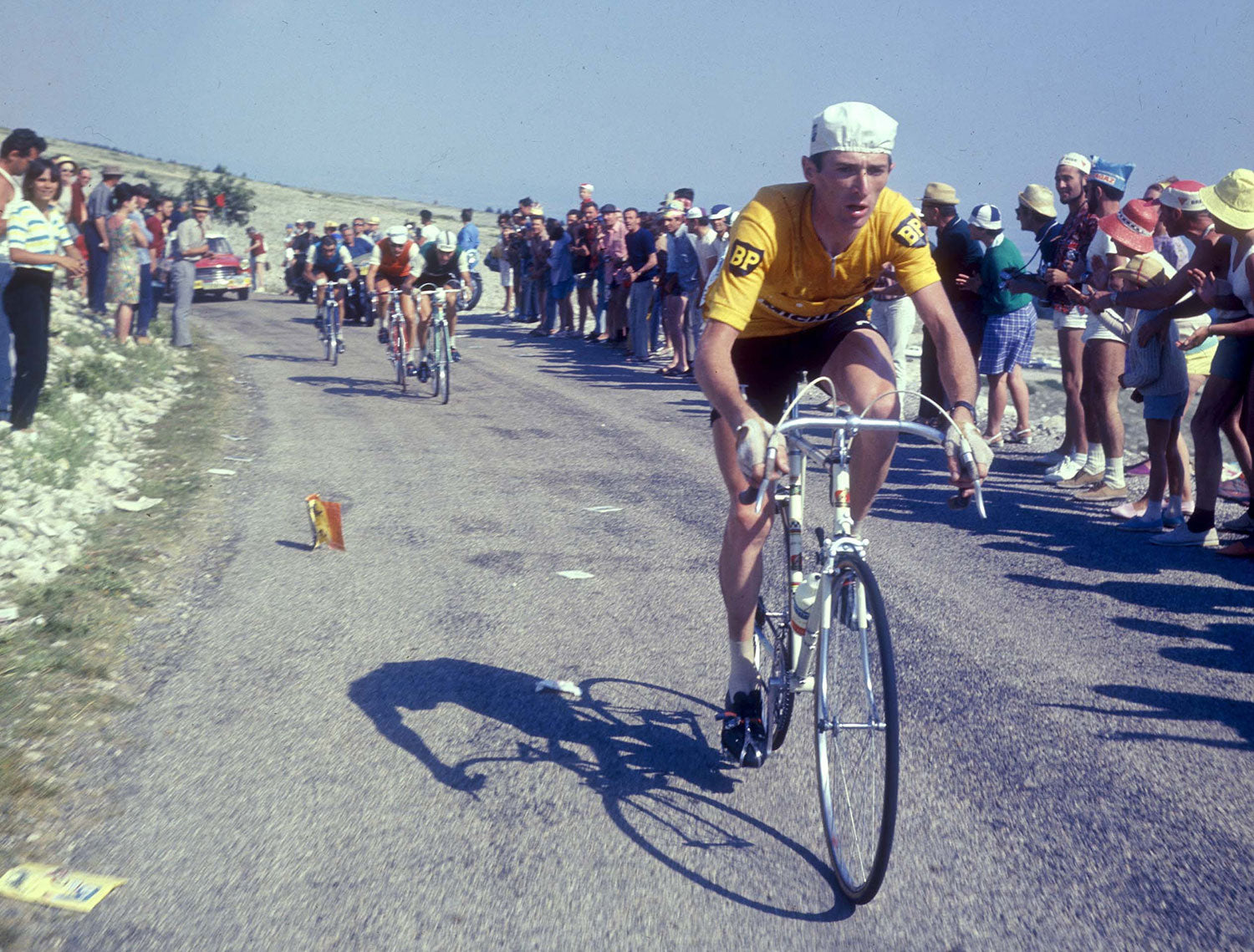
Roger Pingeon at the front in the yellow jersey at the 1967 Tour de France. Photo Credits: Offside / L'Equipe.
The Peugeot cycling team would continue on to great things in the absence of its loved leader, notably Roger Pingeon winning that fateful edition of the Tour, before emerging victorious at the Vuelta a España just two years later (1969). Performances like these would leave the team boasting a glittering palmarès, forever etched into the history books of which few teams will ever match.
Peugeot, a team set up just after the wave of Dunlops pneumatic tyre swept across the world, yet, still able to retain relevance to this day, as pro tour pelotons tackling Ventoux ‘tip their caps’ and raise their helmets in respect of their rider in a checkered shirt.
A true bastion of cycling spirit - Tom Simpson (1937-1967).
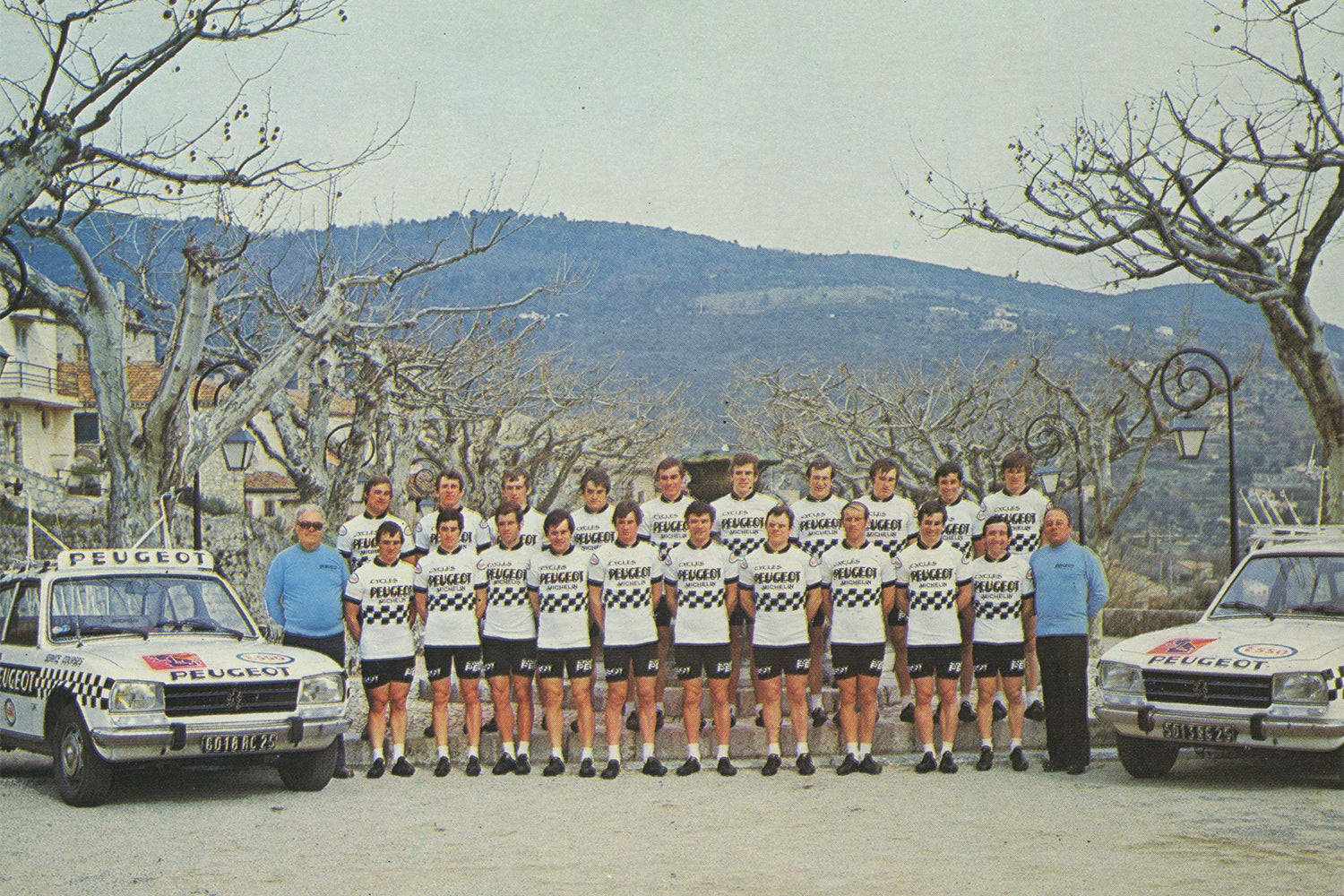
The Peugeot Esso cycling team of 1978 season that featured Bernard Thevenet, Gilbert Duclos-Lasalle, Jean-Luc Vandenbroucke, Guy Sibille, Patrick Beon, Jacques Esclassan et al.

Buy the Peugeot retro cycling jersey and matching cotton cycling caps, socks and shorts at Prendas Ciclismo. Photo Credit: Sean Hardy.
Also in News and articles from Prendas Ciclismo

Prendas' Best-Selling Caps of 2024
January 21, 2025 4 min read
With 2024 in the books, we're looking back at your favourite caps of the year. From cult classic movies to the jungle with a whole lot of Italian flair, check out our best-sellers and grab a new cap!

Vas-y Barry! Hoban wins Ghent-Wevelgem for Gan Mercier Hutchinson
May 15, 2024 8 min read
In an extract from his autobiography, Vas-y Barry, the only British winner of Ghent-Wevelgem, Barry Hoban tells how he won the cobbled classic in 1974, beating Eddy Merckx and the cream of Belgian cycling.

Our Best Selling Caps of 2023
January 15, 2024 4 min read
We know caps here at Prendas Ciclismo, and we know that you love all the styles we have on offer. So every year, we look back at our best-selling cycling caps for the previous year for you to discover a few new styles. Is your favourite cycling cap featured on our list? Read on and see!
Subscribe
Sign up to get the latest on sales, new releases and more …

